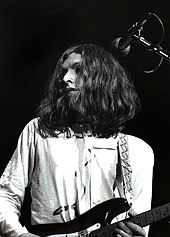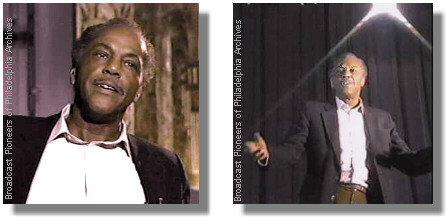Blue-eyed soul (also known as
white soul) is a term sometimes used for
rhythm and blues and
soul music performed by
white artists.
[1] The term was coined in the mid-1960s, to describe white artists who performed soul and R&B that was similar to the music of the
Motown and
Stax record labels. Though many
rhythm and blues radio stations would only play music by black musicians, some began to play music by white acts considered to have "soul feeling", which came to be called "blue-eyed soul".
[2][3]
1960s
 The Righteous Brothers
The Righteous Brothers, one of the early artists most closely associated with blue-eyed soul
Georgie Woods, a Philadelphia radio DJ, is thought to have coined the term "blue-eyed soul" in 1964, initially to describe The Righteous Brothers, then white artists in general who received airplay on rhythm and blues radio stations.[3][4][5] The Righteous Brothers, who were then most associated with the term, named their 1964 LP Some Blue-Eyed Soul.[6][7] According to Bill Medley of the Righteous Brothers, R&B radio stations who played their songs were surprised to find them to be white when they turned up for interviews, and one DJ in Philadelphia (unnamed by Medley but probably Georgie Woods) started saying "Here's my blue-eyed soul brothers", and it became a code to signal to the audience that they were white singers.[8] The popularity of The Righteous Brother who had a hit with "You've Lost That Lovin' Feelin'" is thought to have started the trend for a number of R&B radio stations to play songs by white artists with "soul feeling" (i.e. blue-eyed soul) in the mid-1960s, a more integrative approach that was then popular with their audience.[2] Blue-eyed soul then became a loosely used term to describe many white artists, including Sonny & Cher, the Beatles, Tom Jones, Sam the Sham, Barry McGuire, and Roy Head.[9]
White musicians playing R&B music, however, began before the term blue-eyed soul was coined. For instance, in the early 1960s, one of the rare female blue-eyed soul singers was
Timi Yuro, whose vocal delivery and repertoire were influenced by African American singers such as
Dinah Washington.
[10]
 Steve Winwood
Steve Winwood performing with
Traffic, 1969
Lonnie Mack's 1963 gospel-infused vocals earned him widespread critical acclaim as a blue-eyed soul singer.
[11] Groups such as
The Rascals (originally The Young Rascals) had soul-tinged pop songs,
[12] but it was the soulful vocals of
Felix Cavaliere that gave them the blue-eyed soul sound. By the mid-1960s, British singers
Dusty Springfield,
Eric Burdon and
Tom Jones had become leading vocal stars of the emerging style.
[13] Other notable UK exponents of blue-eyed soul included
The Spencer Davis Group (featuring singer-organist-guitarist
Steve Winwood) and archetypal
mod band
The Small Faces, whose sound was heavily influenced by the Stax label's house band
Booker T. & the M.G.'s. Blue-eyed soul singer,
Chris Clark became the first white singer to have an R&B hit with Motown Records in 1966. Most of the leading UK pop groups of the period – including
The Beatles,
The Rolling Stones,
The Kinks and
The Who – regularly covered Stax and Motown tracks on record or in concert, and all of them have acknowledged the influence of Motown and Stax artists on their music.[
citation needed] In 1967,
Jerry Lee Lewis, whose latter days at
Sun Records (1961–63) had been characterized by R&B covers, recorded an album for Smash entitled
Soul My Way.
Delaney and Bonnie (Bramlett) produced the blue-eyed soul album
Home on Stax in 1969.
[14]
Michael Sembello, who left home at age 17 to tour with
Stevie Wonder, wrote and performed on numerous blue-eyed soul hits for Wonder, Brian McKnight,
David Sanborn, Bill Champlin and
Bobby Caldwell.
Todd Rundgren began his career in Woody's Truck Stop, a group based on the model of the
Paul Butterfield Blues Band. He left the band to form the
garage rock band
Nazz in 1967.
Outside the Anglo-American scene, in
Italy,
Mina and
Carmen Villani fused elements of soul music with the traditional
Italian pop music.
[15][16][17][18][19] Carola and
Doris were notable Scandinavian artists who were influenced by soul music.
[20][21][22][23]
1970s
In February 1975,
Tower of Power became the first white/mixed act to appear on
Soul Train. Also in 1975,
David Bowie, another early white artist to appear on
Soul Train, released
Young Americans, a popular blue-eyed soul album. It featured the funk-inspired "
Fame", which became Bowie's first number-one hit in the US.
Hall & Oates' 1975
Silver Album (real title
Daryl Hall & John Oates) includes the ballad "Sara Smile", long considered a blue-eyed soul standard. "She's Gone", another soulful hit, was originally released in 1973 but did better as a re-release after "Sara Smile".
Average White Band is a Scottish funk and R&B band who had a series of soul and disco hits between 1974 and 1980, their biggest two being "
Pick Up the Pieces" from their 1975 best-selling album
AWB, and "Cut the Cake" from their 1975
album of the same name.
Boz Scaggs' 1976 "
Lowdown", which featured Scaggs' laid-back vocals and a smooth funky groove, peaked at No. 3 on the Billboard Pop Singles chart (and reaching Top 5 on the R&B chart). In April 1976,
The Faragher Brothers became the first all-white ensemble to make an appearance on
Soul Train. In September that year, white funk band
Wild Cherry released the
Billboard Hot 100 chart topping funk/rock single "
Play That Funky Music" and also went to number one on the
Hot Soul Singles chart. The single would eventually sell 2.5 million copies.
In 1978, The
Bee Gees topped R&B album charts with their
Saturday Night Fever soundtrack, along with several songs from the album, including "
Stayin' Alive", "
Night Fever" and "
You Should Be Dancing", which originally charted back in 1976. The Bee Gees again had a hit album on the R&B charts in 1979 with the
Spirits Having Flown album along with its three pop number-one singles, "
Too Much Heaven", "
Tragedy" and "
Love You Inside Out".
Other blue-eyed soul of the decade include the hits "
How Long" by
Ace (
Paul Carrack, lead vocals), three hits by
Ambrosia, "
How Much I Feel", "
Biggest Part of Me" and "
You're the Only Woman", and
Bobby Caldwell's soul standard "
What You Won't Do for Love".













